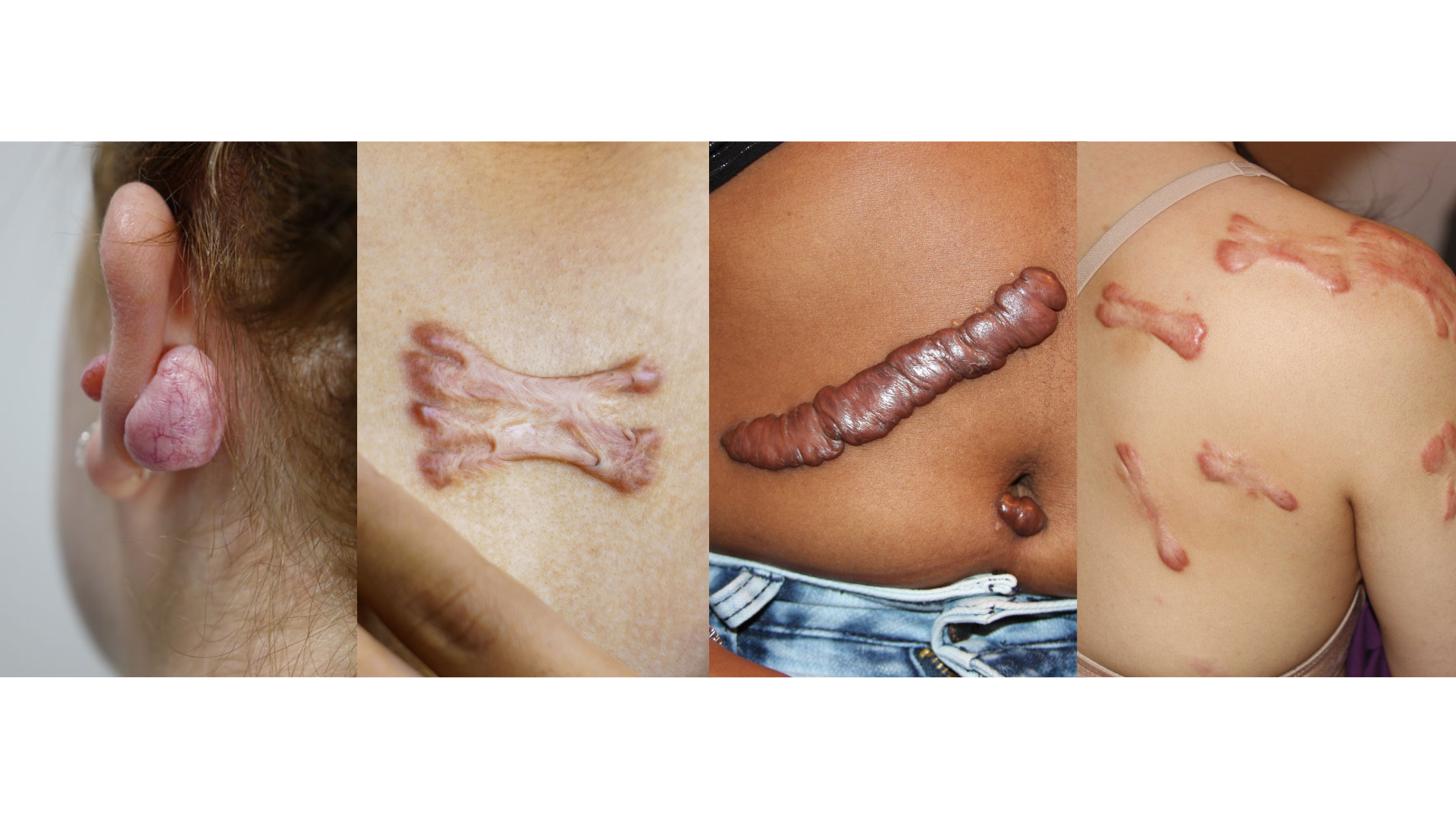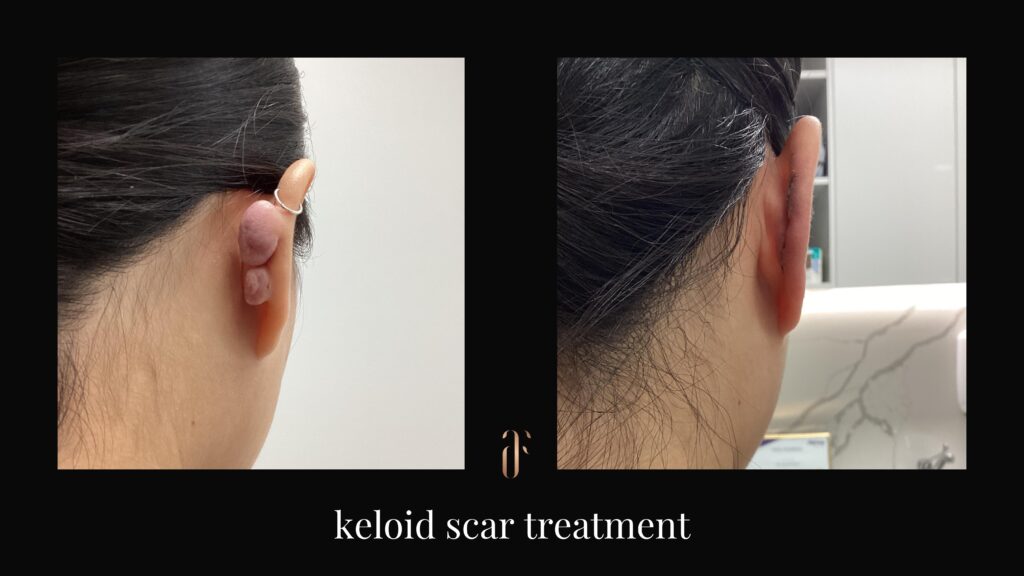
AF Aesthetics is a doctor-led aesthetic clinic committed to offering attentive and personalised care for a variety of concerns. Our experienced team of medical professionals understand that noticeable scars can be unwelcome, especially if they are large or located in a highly visible area such as your face or hand. We offer noninvasive techniques to minimise the appearance of all types of scars, including thick and irregular keloids.
Keloid scars rarely go away on their own and can be challenging to treat. To address the needs of our patients at all stages of their care, our providers emphasise the importance of prevention as well as treatment for keloids and other scars.
What Are Keloid Scars?
A keloid is a type of overgrown scar that rises above and beyond the boundaries of the initial injury.
Scars form in response to a wound, such as a cut, scrape or burn. They play a critical role in the body’s natural healing process, and in most cases, they fade over time due to scar remodelling process. However, in some people, the skin can respond too aggressively to the damage and create scars that are larger than the original wound. Some of these scars are keloids.
Keloid scars come in many different subtypes with considerable variation in size, shape and colour. Some become physically uncomfortable or interfere with movement, which can be a hindrance in daily life. Therefore, treating a keloid scar can be a matter of quality of life improvement as well as cosmetic improvement.
How Does a Keloid Scar Form?
Keloid scars are caused by overproduction of collagen during the healing process after a skin injury.
When your skin is injured, your body’s natural response is to repair the wound by producing new collagen fibres. In most cases, normal levels of collagen production return once the wound has healed, resulting in a smooth, flat scar. However, it is possible for your body to continue producing collagen even after the wound has healed. This results in an excess of collagen that forms a raised keloid scar.
What Are the Identifying Features of Keloid Scars?
 Keloid scars are identified by the following signs and symptoms:
Keloid scars are identified by the following signs and symptoms:
- Thick, irregular cluster of scar tissue
- Raised above the level of the skin
- Purple, red or pink appearance
- Firm, smooth, shiny surface
- Grows beyond the borders of the initial wound area
- May become itchy, tender or painful
- May cause a pulling or tight sensation
- May restrict movement if located over a joint
- Can occur months after the injury
- Rarely resolve on their own
Where Are Keloid Scars Most Likely to Form?
Keloid scars can occur anywhere, though we most commonly see them develop on the following areas of the body:
- Chest
- Shoulders
- Back
- Ears
Who Is Prone to Developing Keloid Scars?
Keloid scars can occur in people of any gender, age or race, but they are more common in people with darker skin tones and people who have a family history of keloid scars. Hormonal changes during pregnancy or puberty may increase the risk of keloid formation. They are also more likely to occur after certain types of injuries or medical conditions, such as acne, piercings, tattoos, burns or chickenpox.
It is not always clear why some people develop keloid scars and others do not. If you are concerned about your risk level, it is a good idea to discuss your concerns with a plastic surgeon or another medical professional if you are undergoing a procedure that may involve scarring.
What Problems Can Occur With Keloid Scars?
Depending on the size of the scar and where it is on your body, a keloid can have more than just a cosmetic impact. Keloid scars can become itchy, painful or tender to the touch, which can be uncomfortable or even debilitating in severe cases. Thick, tight keloids may interfere with normal functioning of the skin and limit movement, particularly if they are located over a joint.
 Keloid scars can be challenging to treat and may grow back even after they are treated. Our experienced medical professionals can suggest measures that may help reduce the odds of a keloid scar returning after treatment or ways to minimise the appearance of a persistent keloid.
Keloid scars can be challenging to treat and may grow back even after they are treated. Our experienced medical professionals can suggest measures that may help reduce the odds of a keloid scar returning after treatment or ways to minimise the appearance of a persistent keloid.
Can Keloid Scars Be Prevented?
The best course of action is to attempt to prevent keloid formation. Although it is not possible to guarantee that keloid scarring will not occur, evidence suggests that early intervention of young scars may provide a more cosmetically appealing outcome.
Some of the ways you can minimise your risk of developing keloids include:
- Keep wounds clean and covered until they heal
- Avoid picking at acne or scabs
- Use silicone gels or patches to help soften and flatten new keloid scars
- Use special dressings to apply gentle pressure to scar tissue
- Protect scars from sun exposure
- Discuss scar management with your medical providers
What Are My Sydney Keloid Scar Treatment Options?
Keloid scars can continue to grow for months and even years. While they eventually stop growing, they rarely disappear without treatment. Options for treatment include:
- Ablative Laser Resurfacing with theCO2RE laserto smooth the scar
- Vascular Laser Treatment with the Vbeam Prima to reduce redness
- Intralesional Injections to help decrease itching and other uncomfortable sensations
- Surgery to excise the scar (typically combined with other treatment options)
 There is no single treatment that works best for all keloids. Our providers will tailor the treatment to your individual needs based upon factors such as the age and type of the scar. In some cases, we may recommend a combination of approaches. Our team will work closely with you to determine an appropriate treatment plan.
There is no single treatment that works best for all keloids. Our providers will tailor the treatment to your individual needs based upon factors such as the age and type of the scar. In some cases, we may recommend a combination of approaches. Our team will work closely with you to determine an appropriate treatment plan.
Request a Consultation for Keloid Scar Removal Treatment at AF Aesthetics in Sydney
A keloid scar can be an unwanted reminder of a past injury or procedure that did not heal as you had hoped. If keloid scarring is having a negative effect on you, our team can help. AF Aesthetics offers various modalities to help minimise the appearance of scars or reduce the risk of developing prominent scars in the first place.
The first step is simply reaching out. Our online form is an easy way to contact our team and schedule your consultation. Otherwise, you may phone us directly on 02 8004 3323.


